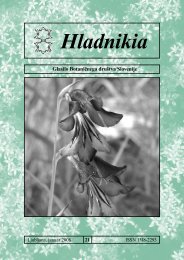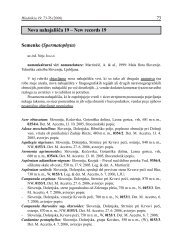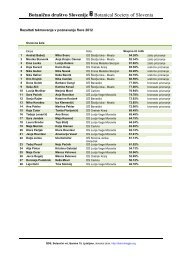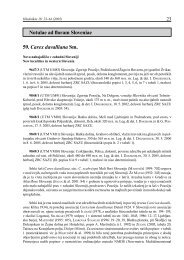PDF formatu - BotaniÄno druÅ¡tvo Slovenije
PDF formatu - BotaniÄno druÅ¡tvo Slovenije
PDF formatu - BotaniÄno druÅ¡tvo Slovenije
Create successful ePaper yourself
Turn your PDF publications into a flip-book with our unique Google optimized e-Paper software.
Hladnikia 20: 17-25 (2007)<br />
23<br />
Marchantia polymorpha ssp. ruderalis<br />
The subspecies ruderalis is the most widely distributed taxon of M. polymorpha in<br />
Slovenia. Apart from the revised herbarium material we can probably add to this subspecies<br />
also most of the sites mentioned in literature where the classification is provided only at the<br />
level of species. This subspecies grows on moist to wet shady spots along streams, on rocks<br />
where water trickles, on moist grasslands, and is also common on secondary sites, especially<br />
on moist concrete walls of regulated streams. The vertical range of thriving is wide, as the sites<br />
range from lowland to the subalpine belt, very rarely they extend also into the alpine belt.<br />
Lunularia cruciata<br />
The species thrives in the Atlantic-Subatlantic and Mediterranean-Submediterranean part<br />
of Europe. It has been synantropically distributed across the larger part of Europe, so it can<br />
be found also outside its natural distribution range, especially in gardens and greenhouses.<br />
Although many authors do not mention it in the context of Slovenia (e.g. Pav l e t i ć 1955,<br />
Dü l l & al. 1999), it was mentioned for Slovenia in the latest article on the distribution of<br />
liverworts and hornworts in Europe (Sö d e r s t r ö m & al. 2002). This is probably on account of<br />
Loi t l esbe rge r (1905), who found it in Gorica (Stračice), where it grew on the stony wall of a<br />
factory canal together with the species Marchantia paleacea. It was found growing also on<br />
the Soča riverbank, not far from the first site. Nowadays, both these sites are located in the<br />
Italian side of the border.<br />
In the LJU herbarium, specimens of Lunularia cruciata are kept which were collected<br />
by F. Dolšak in Ljubljana in 1920 and 1938, with a footnote »in hortis urbis Ljubljana,<br />
subspontanea«. The species was therefore found in the territory of Slovenia, in a synantropic<br />
site. Nevertheless, there has been no more evidence of the species in the last 70 years, so its<br />
presence nowadays remains questionable.<br />
Plagiochila asplenioides<br />
In the past, there was no distinction made in literature at the level of former varieties,<br />
except for a very few quotations that quoted the species as var. major. To determine its<br />
distribution in Slovenia, we therefore use above all the herbarium information.<br />
Based on the herbarium material in LJU and as well as a few applicable literature sources it<br />
is evident that in Slovenia the species P. asplenioides grows in various forest stands on different<br />
geological and pedological bedrocks from lowland to about 1400 m a.s.l. throughout Slovenia.<br />
Plagiochila porelloides<br />
Apart from the herbarium material, the only literature sources applicable to the<br />
determination of this species' distribution in Slovenia are, only those from the older literature<br />
that quote var. humilis and var minor and some of the newer publications that consider the<br />
current division into two species.<br />
P. porelloides is widely distributed in Slovenia. Ecological range of growth is extremely<br />
wide. The species can be found in natural or secondary sites, on basic or acid geological<br />
and pedological bedrock, in grasslands, in forest stands, on moist rocks and occassionally on<br />
flooded spots along and in streams, from lowland to the alpine belt up to the altitude of 2400<br />
m a.s.l, in all phytogeographical regions.









